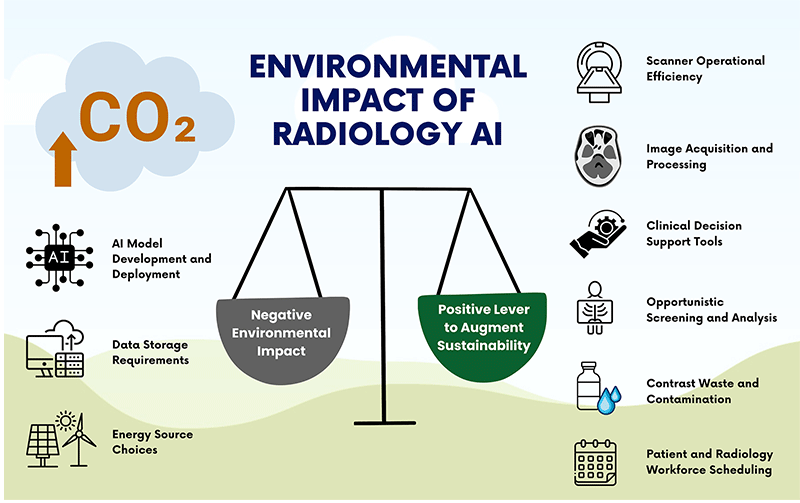Reviewed by Lexie CornerFeb 28 2024
In a focus article published in Radiology, researchers address the environmental impact of artificial intelligence (AI) tools, which are increasingly employed in radiology.
 Summary of how artificial intelligence (AI) in radiology has a negative impact on the environment, with key opportunities and actions to improve sustainability using AI in radiology. Image Credit: RSNA 2024
Summary of how artificial intelligence (AI) in radiology has a negative impact on the environment, with key opportunities and actions to improve sustainability using AI in radiology. Image Credit: RSNA 2024
The emissions of greenhouse gases (GHGs) that drive climate change are mostly attributed to the medical imaging and healthcare industries.
With streamlined imaging procedures that lead to shorter scan durations, enhanced scheduling efficiency to minimize patient travel, and the integration of decision-support systems to decrease low-value imaging, AI solutions can improve radiology practice and sustainability. Nevertheless, using AI has drawbacks.
Medical imaging generates a lot of greenhouse gas emissions, but we often don’t think about the environmental impact of associated data storage and AI tools. The development and deployment of AI models consume large amounts of energy, and the data storage needs in medical imaging and AI are growing exponentially.
Kate Hanneman, MD, MPH, Vice Chair of Research, Associate Professor, University of Toronto; Deputy Lead of Sustainability, Joint Department of Medical Imaging, Toronto General Hospital
Dr. Hanneman and a group of researchers examined the advantages and disadvantages of using AI techniques in radiology. AI can streamline processes, quicken the acquisition of images, lower expenses, and enhance patient satisfaction. However, the energy needed to create AI tools and store the related data adds a substantial amount to greenhouse gas emissions.
Dr. Hanneman added, “We need to do a balancing act, bridging to the positive effects while minimizing the negative impacts. Improving patient outcomes is our ultimate goal, but we want to do that while using less energy and generating less waste.”
Managing the Costs of Cloud Storage
Healthcare facilities must store billions of medical images every year in addition to the massive volumes of training data needed to develop AI models. Many health systems use cloud storage.
Even though we call it cloud storage, data are physically housed in centers that typically require large amounts of energy to power and cool. Recent estimates suggest that the total global GHG emissions from all data centers is greater than the airline industry, which is absolutely staggering.
Kate Hanneman, MD, MPH, Vice Chair of Research, Associate Professor, University of Toronto; Deputy Lead of Sustainability, Joint Department of Medical Imaging, Toronto General Hospital
A data center’s sustainability is significantly affected by its location, particularly if it is near renewable energy sources or in a colder environment.
To reduce the total environmental effect of data storage, the researchers suggested sharing resources and, where appropriate, cooperating with other providers and partners to spread the energy used more widely.
The researchers also proposed further recommendations for reducing greenhouse gas emissions from data storage and the creation of AI models. These included investigating AI algorithms that are computationally efficient, choosing energy-efficient hardware, using data compression methods, eliminating redundant information, putting in place tiered storage systems, and collaborating with suppliers of renewable energy.
Dr. Hanneman added, “Departments that manage their cloud storage can take immediate action by choosing a sustainable partner.”
While there are still obstacles and gaps in knowledge, such as a lack of information on radiology-related greenhouse gas emissions, resource limitations, and complicated laws, Dr. Hanneman expressed optimism that sustainability will be considered when making decisions on AI and radiology.
She concluded, “Environmental costs should be considered along with financial costs in health care and medical imaging. I believe AI can help us improve sustainability if we apply the tools judiciously. We just need to be mindful and aware of its energy usage and GHG emissions.”
Journal Reference:
Doo, F. X., et. al. (2024) Environmental Sustainability and AI in Radiology: A Double-Edged Sword. Radiology. doi:10.1148/radiol.232030.